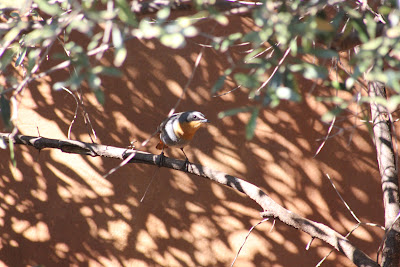To me a lush carpet of pine needles or spongy grass is more welcome than the most luxurious Persian rug.
~ Helen Keller
I felt all bright and breezy today, so Hedgie's Nature Journal is dressed in brand new summer finery (I hope you like it!). Unfortunately Blogger doesn't provide much of a choice and I'm thinking of somehow customising it myself or getting a Custom Domain which might offer more creative themes.
And so is Nature. Bright and breezy I mean, and sporting new summer finery. As the Northern Hemisphere heads into their Autumn, all my trees are sporting new buds and blossoms, new seedlings are popping out and even the Hydrangeas have woken up!
My Chooks are enjoying the sunshine and the new-found greenery. Being free-range, grazing the lawn and eating insects makes out a big part of their diet and while the grass was all brown and dried up, my garden suffered greatly as they ate anything green in sight! The funny thing about my chickens is that they won't eat any greens I prepare for them - I've tried everything, followed recipes from some wonderful chicken blogs, but no go. I've tried hiding it in other food, disguising it and coaxing them to take it from my hand, but they're determined to stick to the lawn.
I've lined up some chores for this summer and one of them is up-grade my hen house and chicken run. I saw a chicken coup make-over on the internet, complete with little lace curtains in front of the windows and nest boxes. Now isn't that grand!
Another chore on my list (I'm a great list-maker, but at least I DO get through it, most of the time!) will be to landscape the area inside the chicken run. The run and hen house were constructed in a great hurry when I accepted a hen and ten babies as a gift early one morning, with nowhere to house them.
An area next to the garage was fenced off and Solly and I started with the make-shift house.
A few poles in the ground, a couple of sheets of galvanised sheeting found in my 'scrap heap' and the basic structure was complete.
Then came the interior - all that was needed at this stage was some straw for ground-cover and a nesting area where Mommy could feel safe with her babies.
The chicks have all grown up into 8
beautiful hens and two lovely roosters, so now it's time for this 'temporary'
arrangement to become a beautiful 'new' addition to my garden.
Lavender
I will be
incorporating plants that will be able to withstand their onslaught on anything
green and also some shrubs and small trees for some shade. Of course I'll be using Lavender (I like the English Lavender) and Sage as well as Geraniums, which they don't eat.
Sage (Salvia officinalis)
They do have free
access to the garden, but on the odd occasion that they have to be kept in, I
would like it to be in beautiful and comfortable surroundings.
::
























